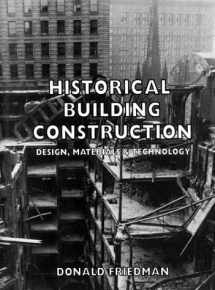
Historical Building Construction: Design, Materials, and Technology
ISBN-13:
9780393702002
ISBN-10:
0393702006
Edition:
First Edition
Author:
Donald Friedman
Publication date:
1995
Publisher:
W. W. Norton & Company
Format:
Hardcover
240 pages
FREE US shipping
Book details
ISBN-13:
9780393702002
ISBN-10:
0393702006
Edition:
First Edition
Author:
Donald Friedman
Publication date:
1995
Publisher:
W. W. Norton & Company
Format:
Hardcover
240 pages
Summary
Historical Building Construction: Design, Materials, and Technology (ISBN-13: 9780393702002 and ISBN-10: 0393702006), written by authors
Donald Friedman, was published by W. W. Norton & Company in 1995.
With an overall rating of 4.1 stars, it's a notable title among other
books. You can easily purchase or rent Historical Building Construction: Design, Materials, and Technology (Hardcover) from BooksRun,
along with many other new and used
books
and textbooks.
And, if you're looking to sell your copy, our current buyback offer is $1.09.
Description
If you practice building renovation, rehabilitation, or preservation, you need to understand the specifics of obsolete construction in order to work in a nondestructive and unobtrusive manner.
Historical Building Construction encourages the design of "elegant" and safe solutions to the structural problems caused by changes in use, changes in architectural design, or changes in the mechanical plant. It enables modern engineers to understand what assumptions their predecessors made, what materials they used, how they designed structures, and how their designs were built. Architects renovating older buildings, while not usually responsible for structural design, need to understand the design restrictions forced on them by the original structures.A guide to the physical construction of buildings from the 1840s to the present, Historical Building Construction uses narrative, drawings, and photographs to describe the development of masonry, wood, and steel construction, modern curtain walls and concrete slabs, and the use of cast iron and patented floor construction. It provides case histories to show how this information is applied to actual projects, ranging from brownstones to skyscrapers.
In order to show a consistent and well-documented set of examples evolving in chronological order, New York City is used as model, since many examples of obsolete forms are still available for examination. The general information given applies, with few exceptions, to buildings of the same types built all over the United States during the same period, and these are referenced as needed.
Every designer who works on old structures or studies them will find in Historical Building Construction help in the process of analyzing existing conditions in a building and suggestions for dealing with what lies hidden behind floor, wall, and ceiling finishes.


We would LOVE it if you could help us and other readers by reviewing the book
Book review

Congratulations! We have received your book review.
{user}
{createdAt}
by {truncated_author}


